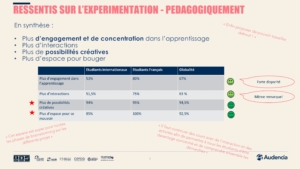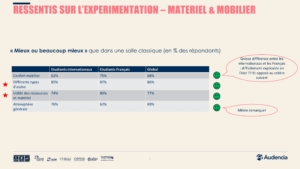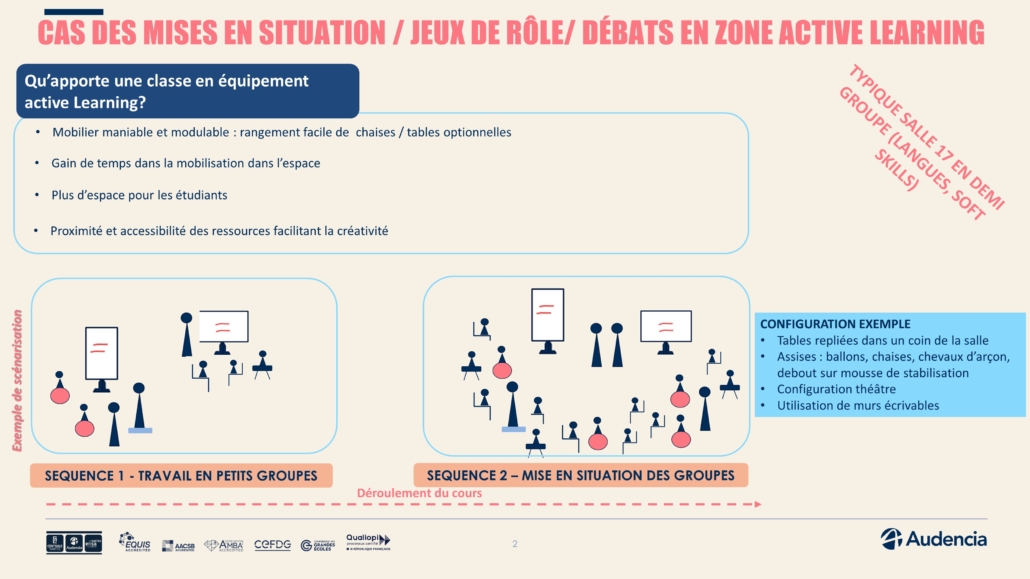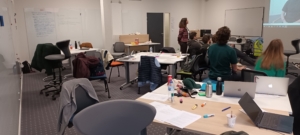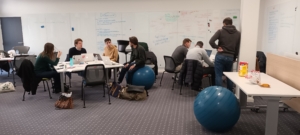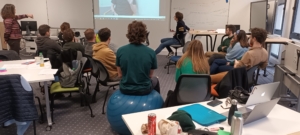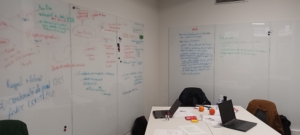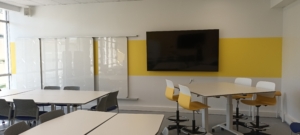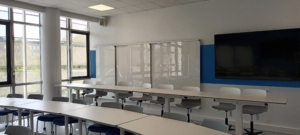- Home
- >
- THINK AND ORGANIZE ITS COURSE
- >
- Environnements d’enseignement et d’apprentissage
- >
- Developing active learning rooms at Audencia
PROJECT ORIGIN
The “active learning zone” project initially came from a group of Audencia employees (DAC professors, LQD pedagogical engineer, DAFO real estate project manager) and was initiated in 2020 during the creation of the ECOS 2025 strategic plan.
The main objective of this project is to develop physical spaces that are fully adapted to active learning, in other words, situations where students can move around, engage in creative activities or communicate with their peers and the teacher (group work, staging, role-playing). The idea: the room configuration must be able to accommodate any of these scenarios in the available space. They should facilitate rather than hinder.
The first experiment took place on the City Campus site, in a dedicated area of the building.
THE PILOT PROJECT - CITY CAMPUS ACTIVE LEARNING ZONE
Needs analysis
While studying what is being done in the field of learning spaces elsewhere in the world, in terms of design, the members of the project group devoted a great deal of time in the autumn to the following elements
- Analysis of the different types of teaching situations in active learning (group work, role-playing, etc.), while also keeping open the possibility of more conventionally-configured courses
- Analysis of the spatial consequences of these types of teaching configurations
- Analysis of the existing spatial configuration of the premises hosting this project: position of doors, windows, video projection equipment, number of m2 available in each room, etc.
- Requirements linked to the programme audiences: average group size, etc.
Setting up a creative resource centre
Reflecting on the ways of learning and the types of teaching situations developed at Audencia also enabled the project group to think about all the small items needed for teaching activities, such as pencils, glue, cardboard, etc. A storage area for all the supplies near these rooms has been set up and is a real bonus for the teacher.
A temporary storage area for student productions has even been set up, so that students can store their in-progress productions if they are made over several sessions.
Initial feedback from teachers and students
Initial feedback from teachers shows that they have a positive or very positive view of the use of the room, for example having several types of seating (64%), more manageable furniture (86%) and walls that can be written on (86%).
Overall, they appreciate the freedom offered by this modality, the space, the flexibility within the same area, and the resource centre. The students concentrate better and are more focused on their learning.
Student feedback indicated that overall they appreciate the comfort of the chairs, and very much like having different types of seating (86%), as well as the usefulness of the resources and equipment (77%). In terms of the learning experience, a very large majority of students (between 80% and 97%) appreciate the fact that they have more creative possibilities, more interaction and more space. As a result, they feel more committed to their learning overall (67%).
Student data
Rolling out the project to other Audencia sites
The development of the Active Learning Zone at City Campus was a first step.
In 2023, the idea is to develop similar spaces at Atlantic and on the Paris site, which will be completed in September 2023: :
- The rooms on the 1st floor of Atlantic will be equipped in active learning format, with particular emphasis on the language rooms
- On the Paris site, an active learning room will be installed on each floor.
Consideration is still being given to creative teaching materials, as the Atlantic site does not have a physical location for a resource room. Alternatives are currently being considered. It should be noted that for some years the Atlantic site has already had 3 collaborative lecture theatres, a Learning Lab and a room known as “Tipping Point” dedicated to continuing education, enabling this type of approach to be developed.




